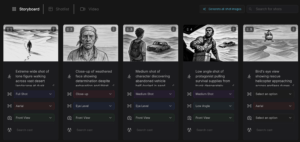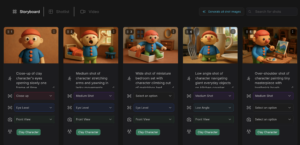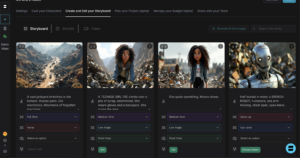Introduction
In the fast-evolving world of content creation, storyboarding remains a critical step, but traditional methods can be time-consuming and expensive. Fortunately, AI storyboard tools are emerging as a game-changer, offering faster and more efficient ways to visualize scripts and concepts. In this article, we’ll dive into a detailed comparison of two prominent players in the field: Shai vs Sora OpenAI. Understanding the nuances between these AI storyboard generator platforms is crucial for creative professionals looking to streamline their workflow. We’ll explore their features, pricing, and overall suitability for various storyboarding needs. Discover which AI storyboard tool—Shai or Sora OpenAI—best aligns with your creative vision and project requirements. Read on to find out which platform can revolutionize your storyboarding process.
Comparison Table: Shai vs Sora OpenAI Features
To give you a clearer picture of which AI storyboard tool might suit you best, the Shai vs Sora OpenAI features show a detailed comparison across several key aspects.
| Feature | Shai | Sora OpenAI |
|---|---|---|
| Primary Purpose | AI-powered storyboard generation from scripts or concepts, focusing on pre-visualization for filmmaking and creative projects. | Video generation from text prompts, allowing users to create realistic videos for various applications. |
| Speed | Rapid storyboard creation; generates a complete visual storyboard instantly after script upload. | Generates videos in a few minutes, but it may take up to a minute for Sora to generate the video. |
| Ease of Use | User-friendly interface designed for creative professionals; no prompt engineering skills required. | Requires familiarity with prompt engineering to achieve desired video outputs. |
| Output Quality | High-quality, consistent storyboard frames with character and style control using curated AI models. | Realistic videos with complex scenes and accurate details, but may struggle with complex actions over long durations. |
| Pricing | Offers a range of subscription plans, including a free trial and tiered options suitable for freelancers and studios. | Included with ChatGPT Plus and Pro subscriptions; Pro plan offers more usage, higher resolutions, and longer durations. |
| Best For | Filmmakers, advertising agencies, animation studios, and creative teams seeking efficient and professional AI storyboard software. | ChatGPT Plus and Pro users seeking to generate realistic videos from text prompts for various creative and entertainment purposes. |
Why AI Storyboarding Matters

The integration of AI into storyboarding marks a significant leap forward for the creative industry. As opposed to traditional methods, which can be time-consuming and resource-intensive, AI storyboarding offers a streamlined, efficient, and cost-effective solution. This shift is driven by the increasing demand for faster content creation cycles and the need to visualize ideas quickly and collaboratively. With an AI storyboard tool, creators can now generate visual sequences from scripts or concepts in a fraction of the time it would take using manual processes.
Key Benefits of AI Storyboarding
AI storyboarding software offers several key advantages:
- Speed and Efficiency: Rapidly generate storyboards, allowing for quicker iteration and feedback.
- Cost Reduction: Lower production costs by reducing the need for extensive manual labor.
- Enhanced Visualization: Easily visualize and refine concepts, improving communication and collaboration.
- Accessibility: Democratize storyboarding, making it accessible to individuals and smaller teams with limited resources.
Industry Applications
The benefits of AI storyboarding extend across various industries, including:
- Advertising: Creating compelling advertising campaigns with rapid concept visualization.
- Animation: Streamlining the pre-visualization process for animated content.
- E-learning: Planning and visualizing engaging e-learning modules.
By leveraging AI, these industries can significantly enhance their creative workflows, reduce production times, and improve the overall quality of their content.
Examples of AI Storyboards

Shai’s intuitive interface where users can upload a script and generate visual storyboards, complete with scene sequencing, shot duration, and voiceover options — all in one platform.
AI storyboards are revolutionizing various industries by providing a faster, more efficient way to visualize and plan projects. Let’s explore some practical examples of how AI storyboard software like Shai and Sora OpenAI can be applied.
Example 1: Advertising Campaign Storyboard
Imagine an advertising agency tasked with creating a 30-second commercial for a new beverage. Traditionally, this would involve hiring storyboard artists to manually draw each scene based on the script, which can take days or even weeks. With an AI storyboard tool, the agency can upload the script to an AI storyboard generator and instantly receive a complete visual storyboard. This allows the team to quickly review the sequence, make adjustments, and finalize the concept, saving significant time and resources.
Example 2: Animation Pre-visualization

In animation, pre-visualization is crucial for planning complex scenes and character movements. Traditionally, animators would create rough sketches and animatics to get a sense of the flow. However, with AI storyboarding tools, animators can generate detailed storyboards with consistent character designs and visual styles in a fraction of the time. For instance, Shai’s character and style control features allow animators to develop and reuse consistent characters and visual styles across different scenes, streamlining the pre-visualization process.
Example 3: E-learning Module Planning
E-learning module developers need to create engaging and informative content that effectively conveys key concepts. AI storyboarding tools can help them quickly visualize the structure and flow of their modules. Instead of spending hours creating mockups and wireframes, they can use an AI storyboard tool to generate a series of visual representations of each section, including text, images, and interactive elements. This allows them to refine the content and ensure a cohesive learning experience.
What Is Shai?
Shai is an AI storyboard generator designed to streamline the pre-production process for filmmakers, advertisers, and content creators. It stands out by offering a user-friendly experience focused on quickly transforming scripts and ideas into visual storyboards. Shai’s core functionality includes AI-powered storyboard generation from uploaded scripts, concept development through simple story prompts, and the ability to create basic animated sequences from storyboard frames. The platform is designed to give users creative control without the complexity of traditional methods, making it accessible to both individuals and teams. Trusted by professionals from Netflix, Territory Studio, Atomic Cartoons, Hogarth, and many more, Shai is the AI storyboard software that helps you visualize your story instantly — from pitch to post-production prep.
Start Creating Your Own AI Storyboards Now
What Is Sora OpenAI?
Sora, developed by OpenAI, is an AI-powered video generation model that creates realistic videos from text prompts. Accessible via sora.com, it allows users to generate videos up to 1080p resolution and 20 seconds long, with options for widescreen, vertical, or square aspect ratios. Sora also supports incorporating user-provided assets to extend, remix, and blend content, or to generate entirely new content from text. This AI storyboard tool is designed to understand and simulate reality, marking a significant step toward AI models that can interact with the physical world.
Key Features of Sora OpenAI
Sora offers a range of features, including the ability to generate high-resolution videos from text, images, and videos. Its storyboard tool enables precise input specification for each frame, allowing for detailed control over the video’s narrative. Users can also access Featured and Recent feeds for community-generated content, providing inspiration and examples. Sora is available to ChatGPT Plus and Pro subscribers, with the Plus plan offering up to 50 videos at 480p or fewer videos at 720p per month, and the Pro plan providing 10x more usage, higher resolutions, and longer durations.
Key Differences: Shai vs Sora OpenAI
While both Shai and Sora OpenAI venture into the realm of AI-driven visual content creation, they diverge significantly in their approach and capabilities. Understanding these key differences is crucial in determining which platform best aligns with your specific needs.
Purpose and Design Philosophy
Shai is built as a dedicated AI storyboard software, focusing on streamlining pre-production for filmmakers, advertisers, and content creators. Its design philosophy centers around providing a user-friendly environment for rapidly visualizing scripts and concepts. Sora OpenAI, on the other hand, is a broader video generation model that can be used as a storyboard tool, but it is not its primary function.
Workflow Complexity
Shai offers a simplified workflow tailored for storyboard creation. Users can upload scripts and generate visual sequences in seconds. Sora OpenAI’s workflow can be more complex, potentially requiring more iterative prompting to achieve desired storyboard frames.
Output Consistency
Shai is designed to maintain consistent character and style across different scenes, which is crucial for effective storyboarding. This consistency is achieved through custom LoRA models trained for style fidelity. Sora OpenAI may require more effort to ensure visual consistency throughout an entire storyboard sequence.
Collaboration Features
Shai is built with team collaboration in mind, offering features that facilitate easy sharing of storyboards. While Sora OpenAI allows for video generation, it may lack the dedicated collaboration tools that Shai provides for streamlined team workflows.
Learning Curve
Shai distinguishes itself with a user-friendly interface that minimizes the learning curve, allowing users to quickly generate storyboards without extensive AI knowledge. Sora OpenAI, with its broader range of functionalities, may present a steeper learning curve, especially for users primarily interested in storyboard creation.
Why Shai Is Better for AI Storyboarding

Shai storyboard view showing AI-generated frames from uploaded script
While Sora excels as a general-purpose video generation tool, Shai distinguishes itself by being specifically designed and optimized for AI storyboarding. This focus translates into several key advantages that make Shai the preferred choice for creative professionals seeking to streamline their pre-production process.
Speed and Efficiency
Shai’s AI storyboard software is engineered for speed, allowing users to upload a script and generate a complete visual storyboard in a matter of seconds. This rapid turnaround time significantly accelerates the pre-visualization phase, enabling teams to iterate on ideas and explore different creative directions with unparalleled efficiency. Sora, while powerful, may not offer the same level of speed and efficiency when used specifically for storyboarding due to its broader focus.
AI Storyboard Software Features
Shai boasts a range of features tailored to the unique needs of storyboarding, including script-based shot extraction, character and style control, and a multimodal prompting system. These features empower users to maintain consistency, refine their visual narratives, and achieve a professional-grade output with ease. Sora’s feature set, while extensive, may require more manual adjustments and workarounds to achieve the same level of precision and control in a storyboarding context.
Cost Efficiency
Shai’s transparent and affordable pricing model makes it an accessible solution for teams of all sizes. By replacing expensive storyboarding artists and animatic editors with AI-enhanced workflows, Shai offers a cost-effective alternative that can significantly reduce pre-production expenses. Sora’s pricing structure, while offering a range of options, may not provide the same level of value for teams primarily focused on storyboarding.
Workflow Integration
Shai’s collaboration-friendly workflow is designed to seamlessly integrate into existing production pipelines. With easy sharing options and future plans for commenting and real-time feedback loops, Shai fosters teamwork and ensures that all stakeholders are aligned on the visual direction of a project. Sora’s collaboration features, while present, may not be as specifically tailored to the needs of storyboarding teams, potentially leading to communication bottlenecks and inefficiencies.
Deep Dive Into Shai’s Features
Shai is more than just an AI storyboard generator; it’s a comprehensive suite of tools designed to streamline the entire pre-production process, infusing AI at every stage. Let’s explore the key features that set Shai apart and make it a powerful asset for creative teams.
AI-Powered Storyboard Generator
At its core, Shai boasts a robust AI-powered storyboard generator. This feature allows users to upload a complete script and instantly generate a visual storyboard. Unlike general-purpose AI tools, Shai is specifically designed to understand and interpret film scripts, commercials, and short content, translating them into structured visual sequences in seconds. This dramatically accelerates pre-production, cutting weeks of manual work down to minutes.
Concept Development Tool
Shai empowers users to develop concepts even without a finalized script. By inputting story ideas, defining the desired tone, format, and video length, Shai can generate tailored concepts that align with specific creative needs. This feature is invaluable for brainstorming and visualizing initial ideas before committing to a full script.
Image-to-Video and Animatic Creation
Taking storyboarding a step further, Shai can turn generated storyboard frames into basic animated sequences, or animatics. This allows users to visualize the flow, pacing, and transitions of their story early in the process, providing a dynamic representation that goes beyond static images.
Character and Style Control
Maintaining visual consistency is crucial for any project. Shai allows users to develop and reuse consistent characters and visual styles across different scenes. This is achieved through custom LoRA models trained for style fidelity and consistency, ensuring a cohesive look and feel throughout the storyboard. This level of control is essential for projects where brand identity or specific artistic styles are paramount.
Collaboration-Friendly Workflow
Shai fosters seamless collaboration among team members and clients. Storyboards can be easily shared, facilitating feedback and iteration. While future plans include commenting, versioning, and real-time feedback loops, the current sharing capabilities already enhance communication and ensure everyone is on the same page. Shai is designed for teams, offering a collaborative environment that streamlines the storyboard creation process.
Shai vs Sora OpenAI Pricing Comparison
Understanding the pricing structures of Shai and Sora OpenAI is essential for making an informed decision. When evaluating Shai vs Sora OpenAI, it’s important to consider not just the upfront costs, but also the long-term value and return on investment (ROI) each platform offers.
Shai Pricing Tiers
Shai offers a range of pricing tiers designed to accommodate different needs and budgets:
- Free Trial: Shai provides a free trial, allowing users to explore the platform’s capabilities before committing to a paid plan.
- Basic – $12/month: This plan includes unlimited projects, 120 images, and 13 videos, making it suitable for individual creators or small teams.
- Freelance – $29/month: The Freelance plan offers 440 images and 44 videos, providing more resources for larger projects.
- Studio – $79/month: Designed for professional studios, this plan includes animatics, priority export and support, 1400 images, and 156 videos, catering to more demanding production needs.
Sora OpenAI Subscription Plans
Sora OpenAI is accessible through ChatGPT Plus and Pro subscriptions. ChatGPT Plus subscribers can generate up to 50 videos at 480p resolution, or fewer videos at 720p each month, without additional cost. For more extensive usage, the Pro plan offers ten times more capacity, higher resolutions, and longer durations. Tailored pricing options are planned for different user types in the future.
Value and ROI Comparison
When comparing Shai vs Sora OpenAI pricing, consider the specific features and resources each platform offers in relation to your project requirements. Shai’s tiered pricing allows users to select a plan that aligns with their usage needs, providing cost-effective solutions for various project scales. Sora’s integration with ChatGPT Plus and Pro offers video generation capabilities within a broader AI toolset. Ultimately, the best choice depends on your project’s scope, required features, and budget constraints. Start creating your own AI storyboards now with Shai and experience the difference.
Conclusion: Shai vs Sora OpenAI Final Verdict
In the landscape of AI storyboarding tools, the comparison between Shai vs Sora OpenAI reveals distinct strengths tailored to different user needs. While Sora offers impressive video generation capabilities, Shai stands out as the superior choice for those seeking a dedicated AI storyboard tool. Shai’s purpose-built design, speed, and efficiency in generating storyboards, combined with its focus on team collaboration and creative control, make it ideal for advertising agencies, animation studios, and e-learning developers.
Shai streamlines the pre-production process, offering cost-effective solutions and AI storyboard software features designed to enhance creative workflows. Sora, while powerful, may present a steeper learning curve and is not specifically optimized for storyboarding. Ultimately, if your priority is rapid, consistent, and collaborative storyboard creation, Shai is the clear winner. Ready to transform your creative process? Start creating your own AI storyboards now and experience the future of AI-powered visual storytelling.